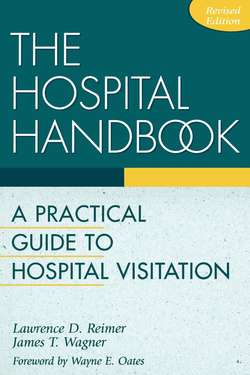Читать книгу Hospital Handbook - James T. Wagner - Страница 16
На сайте Литреса книга снята с продажи.
Getting Oriented
ОглавлениеBegin your tour with the information desk. There is generally a separate file for clergy where patients are listed by religious affiliation. Make sure your denomination is listed in a way that is familiar to your congregation. Communicate this listing to the members of your church so they know how to indicate their affiliation when they go to the hospital.
In another chapter we will discuss ways to activate the minister's role in hospital visiting, but here it is important to note that church members need to be made aware of the importance of the clergy file at the hospital. I have had people refuse to fill out a religious preference card at the hospital out of civil liberty convictions. Here I had to point out that filling out this category helps me find them. My denomination, the United Church of Christ, still has people in it who call themselves Congregationalists, from the parent denomination prior to the merger. I alert the hospital to this dual listing and encourage my members to stick with one name or the other, depending on the characteristics of the community.
No matter how good the system, some names never make it to the religious card file. Therefore it is important to have a standing policy whereby members of the church call you when they or other members are in the hospital.
The second item on your tour should be the visiting policy. What are the hospital visiting hours and when does the hospital prefer to have clergy visit? You may have to balance the hospital's preference with your own convictions. Some pastors like to visit in the morning before regular visiting hours. This gives you a certain amount of privacy and freedom from interruptions by other visitors. However, it is also a time that many of the medical procedures are performed and you may be getting in the way of hospital personnel.
Find out when meals are served and avoid them. This is an awkward time for patient and visitor.
There are times, in emergencies and around surgery, that you cannot follow the most convenient schedule for the hospital. Find out in advance how to get in late at night or early in the morning.
The third piece of information you should obtain is how the hospital will get oriented to you. What will you do about identifying yourself? No one really looks like the stereotype of a minister anymore, so you cannot take it for granted that hospital staff will understand why you are walking through their halls. I have met staff who claim they can always spot a minister, but they've never spotted me. Women and younger pastors all have special difficulty being recognized as clergy. But unless you look like Ichabod Crane, even a middle-aged male will not be easily recognized as a minister.
Find out if the hospital requires you to carry or wear some form of official identification. If not, then it will be up to you to identify yourself. If you wear a clerical collar, this is easy. If this is not your denominational tradition, you will have to make clear who you are. It is important to introduce yourself as a minister at the nurse's station at the floor where you visit. Hospitals are concerned about the security of their patients, and personnel appreciate your courtesy in introducing yourself.
It is also important to find out how the hospital expects you to relate to special areas like the intensive care unit or the emergency room. These are areas which have strict prohibitions for general visitors but which allow clergy special privileges. You need to know your rights for these areas, because staff are not always aware of clergy privilege in specific situations. A later chapter describes some of the unique elements of emergency room and intensive care visitation, but you should find out what policies apply to clergy in your first tour.
